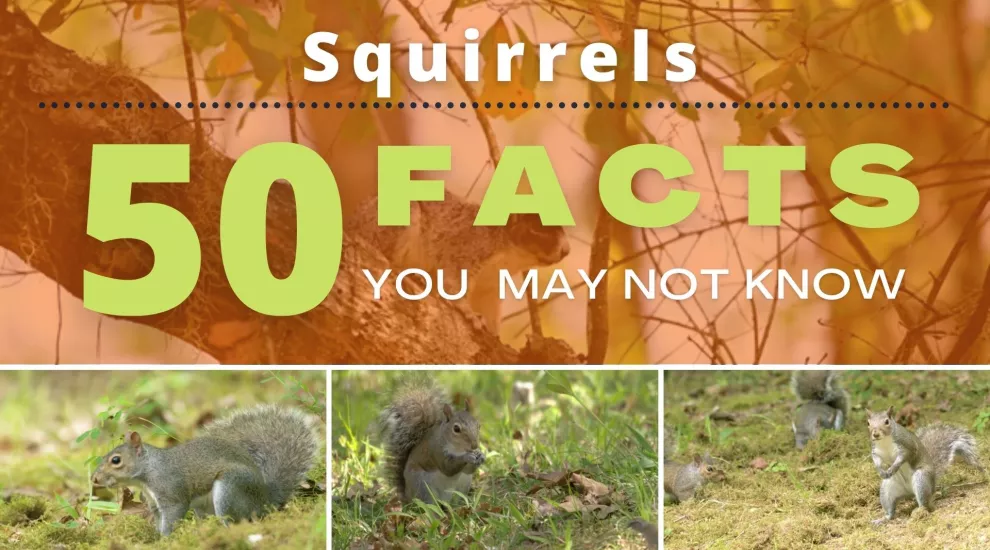
Throughout many of South Carolina’s strong and distinct forests, Squirrels have called these environments home for many centuries.
Forests are large areas of land that are covered distinctively by trees, plants, and other similar organisms. Oftentimes, most animals will call the forest their home and these lands can spread from the coast to the mountains in South Carolina.
Squirrels are a type of rodent that are well known for their ability to climb trees while also preserving several tons of nuts and seeds.
If you are familiar with squirrels or not in addition to their impact on South Carolina, here are 50 fun facts about them!
Squirrels are a part of a unique and amazing South Carolina wildlife that is considered to be one of the most diverse in the country.
Squirrels along with other common creatures are on an extensive list of animals that live in environments that are between them and humans.
Squirrels play an important ecological role in South Carolina’s environment.
Squirrels are known to be essential creatures in the jobs that they have.
Squirrels are in the rodent family which is also the home of rats, mice, and beavers.
Female squirrels can have babies as little as six months old.
Squirrels are well known for their ability to climb trees for resources.
They are also well known for their ability to have a fast reaction to things.
South Carolina is home to two types of squirrel species.
The most common squirrel in South Carolina is the Eastern Grey Squirrel.
Eastern grey squirrels are known to be a powerhouse in forest regeneration in South Carolina.
Forest regeneration is the process that allows a forest to sustain itself through the growth of new plants that replace large forest trees as they die and get older.
Eastern grey squirrels are major predators of seeds and nuts in the woodland ecosystem.
They have a known habit of saving seeds and nuts for later consumption.
The process of squirrels saving all types of nuts for later is known as cashing.
In one season, squirrels can bury up to 10,000 nuts.
However, eastern greys and all other squirrels only recover about a quarter of their nuts that they store for the winter.
Squirrels do not like to spoil any food at all if possible.
One of the most notable features of squirrels is their keen sense of ability to smell things.
Throughout the day, squirrels are highly active in searching for nuts throughout their ecosystem.
If necessary, squirrels and eastern greys can swim in water streams for only short distances.
For all squirrels, if there is not a lot of food supply in their local ecosystems or if the population is too large, they tend to migrate to other areas.
The Southern Fox Squirrel is the second most common squirrel species in South Carolina.
Southern foxes overpass the same habitat location as eastern greys and are seen mostly in coastal South Carolina.
Southern fox squirrels are twice the size of its cousin species, the eastern grey squirrel.
Southern fox squirrels claim pine tree forests as their home around the coastal plain of the Palmetto State.
Southern foxes are considered to be one of the most colorful organisms of their family.
Their colors can range from grey to black to brown.
One of the most distinctive features of the southern fox squirrel is their front teeth that are used often in their day-to-day life.
Their teeth are known as incisors, and they continue to grow as they get older.
Southern fox squirrels will constantly gnaw on objects that they encounter in their daily cycle.
As a result, they will grind their teeth in order to make them stronger and more powerful than previously.
By grinding, squirrels are able to wear down objects and use them for jobs and resources.
Southern foxes will often engage in multiple behaviors such as scent-marking.
In scent-marking, squirrels will rub their cheeks on the surfaces of their environment and food that they capture.
They also use pheromones from the apocrine glands around their mouth to mark their territory for other squirrels and animals in the area.
Scent-marking also allows squirrels to find mates and orient themselves in their habitat that they are living in.
Pheromone is a type of chemical substance produced by some animals that causes a social response in members of the same species.
Pheromone serves many different purposes in terms of communication by squirrels.
The first is a warning system to the forest that is nearby, and potential predators are in the area.
The second is regular communication between squirrels and other similar species.
Southern foxes and all other squirrels will comply themselves with tail whipping.
Tail whipping is a sign that predators have been spotted nearby.
As of today, southern fox squirrels have become much more of a rarer sight throughout many of South Carolina’s coastal forests.
This is mainly because of habitat loss and changes to the environment that southern fox squirrels face daily.
However, thanks in part to barrier islands, southern fox squirrels have continued to thrive and grow their populations.
This is due to the islands being isolated and tough to access for humans without a boat or ferry in place.
The most common place for South Carolinians to find the southern fox squirrel is on Daufuskie Island which has been their main home for decades.
People can visit these squirrels through the island’s Eco Tours system.
Daufuskie’s Eco Tours provides fun experiences not only about the island, but strong information about southern foxes and their importance to the island.
For more information about squirrels in South Carolina, be sure to visit our What’s Wild program on these creatures for a more digitalized look!
{"preview_thumbnail":"/sites/default/files/styles/video_embed_wysiwyg_preview/public/video_thumbnails/NcfH0gcq978.jpg?itok=5-hLVh76","video_url":"https://youtu.be/NcfH0gcq978","settings":{"responsive":true,"width":"854","height":"480","autoplay":false},"settings_summary":["Embedded Video (Responsive)."]}
